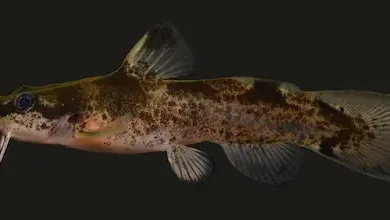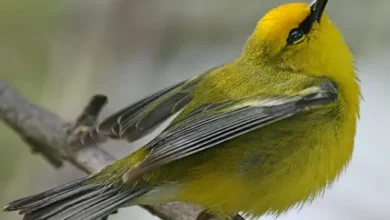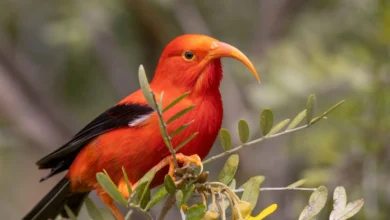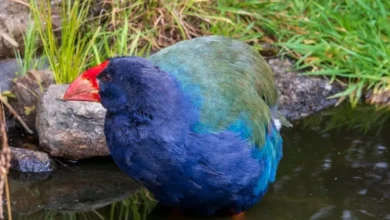Golden Toad Diet: What This Extinct Amphibian Ate and Why It Mattered
A brief orientation to the species
The golden toad (Incilius periglenes, formerly Bufo periglenes) was a tiny, visually striking true toad that lived only on a cool, wet ridge above Monteverde in Costa Rica’s Tilarán Range. Adults were most visible during a brief, explosive breeding season in the first heavy rains of spring; the rest of the year they were fossorial—living in burrows or crevices in the soil and leaf litter of the elfin cloud forest. By the late 1980s, after a precipitous crash, the species vanished; the IUCN has listed it as extinct since the early 2000s. amphibiaweb.orgWikipedia
Those life-history traits—fossorial habits, tiny body size, a short above-ground window—are central to understanding its diet: what the toads could find, when they could forage, and which food items fit their physiology.
The evidence problem (and why it’s okay to make careful inferences)
There are no dedicated field studies that catalogue the golden toad’s prey. Authoritative natural-history summaries say plainly that “little information” exists on its food habits and suggest, based on size and family, that it likely fed on small invertebrates. That’s sparing, but it’s a reliable compass: bufonid toads of comparable size in similar habitats overwhelmingly eat small arthropods—ants, mites, small beetles, springtails, tiny spiders, and soft-bodied larvae—taken from the leaf litter and low vegetation. Animal Diversity Web
With that caveat, we can outline the diet by pairing what’s known about the species’ timing and behavior with well-studied feeding patterns of related toads, and with the prey communities known to be abundant in cloud-forest leaf litter. The result is a nuanced picture that distinguishes documented facts from reasoned inference.
Adult diet: likely dominated by tiny leaf-litter arthropods
The “what”: small prey that fit a small mouth
Adult golden toads were roughly 4–5 cm snout-to-vent length. That scale constrains gape width and therefore prey size. Toads this small typically take:
-
Ants (Formicidae) and mites (Acari)—ubiquitous, abundant, and the right size for continuous, low-risk foraging.
-
Collembola (springtails)—soft-bodied, abundant microarthropods in wet moss and leaf litter.
-
Small beetles (e.g., minute ground beetles and rove beetles), fly larvae, tiny spiders, psocopterans, and leafhoppers/planthoppers—all common in cloud-forest litter and understory.
That list is inferred from (a) the well-documented prey spectrum of small bufonids and (b) the cloud forest’s invertebrate community structure, which is strongly leaf-litter-driven. The golden toad’s fossorial tendencies reinforce the inference: animals that spend much of their time in or under the substrate feed on what’s within a short striking distance of a burrow entrance—micro-arthropods that move across the litter surface or through the upper soil layer. Animal Diversity Web
The “how”: sit-and-wait strikes in the litter
Toads are classic lingual feeders: a rapid, ballistic tongue flip secures prey at very short range. Small bufonids generally use a sit-and-wait micro-ambush tactic, repositioning frequently over minutes to hours rather than patrolling broadly. For a fossorial species, that often means using burrow entrances as feeding stations when humidity and temperature are favorable (for example, after dusk or during moist conditions), then withdrawing.
Because golden toads were conspicuous above ground mainly during breeding, we should expect two seasonal foraging modes:
-
Outside the breeding season (most of the year): Secretive, fossorial, short-range ambush foraging on minute litter fauna whenever moisture permits surface activity underground.
-
During the breeding season (roughly March–June, aligned with first heavy rains): Foraging opportunities expand dramatically. Adults aggregate around ephemeral pools in tree-root depressions; humidity and temperature are ideal; prey is active; and the toads spend long stretches at or near the surface. Even while courting or clasping, males may opportunistically snap at passing micro-prey. Females, which are larger, may be able to take slightly larger items (small beetles, small orthopterans), but still within a micro-prey envelope. amphibiaweb.org
Nutritional drivers and prey choice
For tiny toads, prey encounter rate and water balance matter more than maximizing calories per item. Ants and springtails are “low-profit” per unit, but they’re everywhere; the cost of missing a larger, rarer insect is higher if you forage only briefly under high-humidity windows. The cloud forest’s steady wetness and cool temperatures also mean slower digestion than in hot lowlands; that favors many small meals rather than a few large ones. In sum, a micro-prey, high-frequency feeding strategy fits the golden toad’s ecology.
Sex differences and size effects
Golden toads were sexually dimorphic in size and color. Females were slightly larger; in many bufonids that translates to marginally larger maximum prey size for females. Still, given the species’ small overall size, both sexes would have heavily overlapped on minute prey. During explosive breeding—when males vastly outnumbered females—male activity budgets were dominated by mate searching and amplexus; that could have reduced time available for foraging for males relative to females, shifting energetic costs onto stored reserves. The short, intense breeding window supports the idea that golden toads built energy stores before the rains and topped off opportunistically around the pools.
Tadpole diet: periphyton, biofilms, and fine detritus
Although we lack diet tables for golden toad tadpoles, their mouthpart morphology and life history (shallow temporary pools; metamorphosis in ≈5 weeks) match a classic bufonid pattern: scraping and grazing on periphyton (algae), microbial biofilms, and fine detritus, with incidental ingestion of micro-invertebrates. In nutrient-poor root-tangle pools characteristic of the elfin forest, productivity is often dominated by algal films and decomposing leaf matter; tadpoles convert that into biomass rapidly under favorable, stable water conditions. When drought hits, these resources shrink fast; when heavy rains flush pools, biofilms and detritus can be scoured away. Both scenarios were documented in breeding failures for this species, underscoring how dietary base and hydrology were tightly coupled. amphibiaweb.org
A short larval period (≈5 weeks) implies a high intake rate of readily assimilated material. In many anurans, that means green algae (e.g., diatoms and chlorophytes) plus bacteria-rich detritus; golden toad tadpoles would have been no exception given their pool type and timeline.
Foraging windows: why timing and weather controlled access to food
Above-ground access is seasonal
Golden toads emerged with the first reliable rains of the wet season. In Monteverde’s climate, seasonal transitions are sharp: the onset of the rains raises humidity, dampens litter, and ignites activity in invertebrate communities. That sudden explosion of prey availability likely tracked the toads’ appearance and breeding assemblies. Outside those weeks, the toads’ subterranean existence kept them buffered from desiccation but also constrained their access to the densest prey swarms at the surface. amphibiaweb.org
Microclimate matters—even underground
Cloud forests are wet, but the dry season at Monteverde can be pronounced, and upper soil layers may still lose moisture. For a small amphibian with permeable skin, water balance is paramount; feeding bouts likely concentrated in narrow time slots—night, foggy mornings, or immediately after mist/rain events—when the microclimate allowed the toads to surface near burrows without undue water loss. That’s consistent with the species being mostly invisible to observers except during breeding.
The golden toad in the cloud-forest food web
Trophic position: small predator, big throughput
In any rainforest, leaf-litter micro-predators quietly move a lot of energy by eating countless tiny arthropods. The golden toad sat in that role: a mesopredator of minute prey. Its likely diet implies it helped:
-
Thin ant populations at micro-scales around burrows and breeding pools.
-
Cull early instars of beetles and flies.
-
Recycle nutrients, converting microbial production (via tadpoles) and litter arthropods (via adults) into biomass for higher predators.
Predators of the toad (and how diet connects)
Small snakes (e.g., Liophis/Erythrolamprus spp.), larger frogs, and invertebrate predators like large spiders prey on small anurans in cloud forests. A diet centered on tiny prey doesn’t deter predation; instead, the toad’s fossorial lifestyle likely reduced encounter rates with visual predators during non-breeding months. Around breeding pools, where adults aggregated conspicuously, any foraging near open water would have traded safety for prey density.
Morphology and feeding mechanics: what the body tells us about the menu
The golden toad lacked an external tympanum and vocal sac; it was not a calling species in the typical bufonid sense and relied more on visual cues during breeding. That’s relevant not because ears eat but because behavioral ecology shapes activity budgets, which shapes when and how you feed.
Otherwise, its cranial and lingual anatomy would have conformed to bufonid norms: a fast, sticky tongue for short-range strikes on small, moving prey; maxillary teeth absent (as in toads generally), so no grasping or chewing—prey size had to be small enough to be swallowed whole. The limbs were proportionally long for the body, aiding short lunges among root mats and over mossy substrates where micro-prey scurry. amphibiaweb.org
How breeding ecology intersected with diet
Explosive breeding around ephemeral pools
Golden toads bred in shallow, often root-bound puddles just a few centimeters deep. These micro-habitats act as prey magnets: hatching midges, mosquito larvae, and other aquatic or semi-aquatic insects concentrate near the waterline; terrestrial springtails and ants patrol the saturated edges. During the several-week breeding period, adults likely exploited this ring of abundance, snapping at tiny arthropods moving across wet mud and moss.
But the same ephemerality that created pulses of prey also threatened larval food supplies: when the rains were late or erratic, entire clutches desiccated; when rains flushed too hard, pools were scoured. In both extremes, the algal/biofilm base that tadpoles depend upon would have been reduced—an indirect, dietary pathway by which climate variability could depress recruitment. That dynamic was observed in the species’ final years, when pool desiccation coincided with recruitment failure. amphibiaweb.org
Energetic budgeting under male-biased sex ratios
In many explosive-breeding anurans, males compete intensely and may fast or feed minimally while guarding or clasping females. Golden toads often experienced male-biased aggregations by large margins; the upshot is that males likely relied on pre-breeding energy stores, doing only opportunistic feeding at the pools. Females, larger and carrying eggs, had higher energy demands and may have foraged more actively before and between mating events. amphibiaweb.org
Diet plasticity and environmental change
Because the golden toad’s diet was likely built on ubiquitous micro-prey, one might think it was buffered against environmental change. Two realities complicate that idea:
-
Moisture controls prey activity. Springtails, mites, and ants at the soil surface respond minute-to-minute to humidity. Drier microclimates reduce surface activity and thus reduce encounter rates for a sit-and-wait micro-predator.
-
Hydrology controls tadpole food. Algal/biofilm accrual in small pools depends on stable water levels, light, and nutrient inputs. Rapid dry-down starves larvae; flushing resets biofilms to zero. The species’ documented breeding failures in dry years show how quickly the dietary base for larvae can collapse when hydrology shifts. amphibiaweb.org
Compounding these were the toads’ extremely small range (just a few square kilometers) and narrow elevation band; any local climatic anomaly (e.g., the intense dry anomalies linked to El Niño events in the 1980s) could have synchronously impacted prey and primary productivity, with no adjacent refuges to buffer the population. Wikipedia
Comparisons with close relatives: anchoring inference
When direct diet data are missing, ecologists often triangulate using phylogenetically and ecologically similar species. Several small Central American Incilius (and former Bufo) species that live in wet, mid- to high-elevation forests show:
-
Adult diets dominated by ants and other small litter arthropods.
-
Tadpoles that graze periphyton in shallow, temporary pools.
-
Seasonal shifts in foraging opportunity tied to rainfall regimes.
Golden toad’s morphology and breeding ecology line up with that template, strengthening the inference that its diet followed the same pattern—even if the exact prey percentages can’t be reconstructed without stomach-content data.
Methods that could have revealed more (and why they weren’t feasible in time)
Had the species persisted longer, several standard tools could have resolved its diet:
-
Stomach flushing (nonlethal gastric lavage) of adults during breeding aggregations.
-
Stable-isotope analysis (e.g., δ¹⁵N/δ¹³C) of tissues to position adults and tadpoles on the local food web and highlight reliance on particular basal resources.
-
DNA metabarcoding of feces or gut contents to identify cryptic micro-prey like mites and springtails.
-
Periphyton sampling from breeding pools to link tadpole growth to algal community composition.
The tragedy of the golden toad is partly that its sudden decline preceded the widespread use of many of these techniques in field herpetology. amphibiaweb.org
Putting the pieces together: a reasoned dietary profile
Adults (most of the year):
-
Primary foods: ants, mites, springtails, tiny beetles and flies, small spiders—minute arthropods active in moist leaf litter and just under the soil surface.
-
Foraging mode: short, sit-and-wait strikes from or near burrow entrances during humid windows (fog, rain, night).
-
Seasonality: constrained in the dry season, expanded just before and during the onset of rains.
Adults (breeding season, March–June rains):
-
Primary foods: same micro-prey, plus edge-of-water insects and larvae concentrated around ephemeral pools.
-
Foraging mode: opportunistic feeding amidst courtship/amplexus; females likely feed more than amplexed males.
-
Constraints: negotiation between mating effort and feeding time in male-biased aggregations. amphibiaweb.org
Tadpoles (in shallow, temporary pools):
-
Primary foods: periphyton (algae), microbial biofilms on roots and detritus, fine particulate organic matter; incidental micro-invertebrates.
-
Foraging mode: continuous scraping/grazing using keratinized mouthparts along submerged surfaces.
-
Constraints: pool stability; desiccation or flushing events sharply reduce food availability and survival. amphibiaweb.org
Why diet matters for interpreting the extinction
The golden toad’s disappearance has been linked to climate variability and possibly disease, with debate about the exact mix of drivers. Diet is a quiet connector among these hypotheses:
-
Climate → hydrology → tadpole diet: Dry anomalies desiccated pools; wet anomalies scoured them. Either way, the algal/biofilm base was disrupted, undermining recruitment even when eggs were laid successfully.
-
Climate → microclimate → adult prey: Drier, warmer leaf litter suppresses the surface activity of minute arthropods and limits safe foraging windows, potentially reducing adult body condition entering the breeding season.
-
Small range → no buffer: With only a narrow ridge to occupy, any local shock to prey or primary producers would be population-wide. amphibiaweb.orgWikipedia
Diet alone didn’t doom the species; rather, the features of its diet—micro-prey dependence, hydrology-sensitive larval feeding—made it vulnerable to unusually timed or intense dry periods that struck in the 1980s. Those events, in a species with little room to maneuver ecologically or geographically, likely amplified other stresses.
What counts as “known” vs. “inferred” (a concise audit)
-
Known: The species’ habitat (elfin cloud forest near Monteverde), fossorial habit, explosive breeding in shallow pools, short larval period; and that specific diet studies are lacking. amphibiaweb.orgAnimal Diversity Web
-
Inferred with high confidence: Adult reliance on minute leaf-litter arthropods; tadpoles grazing periphyton and detritus; seasonal expansion of foraging opportunities with first rains; minor sex-based differences in maximum prey size. (These match patterns in closely related bufonids with identical habitat and body size.)
-
Inferred with moderate confidence: Males feeding minimally during peak amplexus; opportunistic feeding around breeding pools on edge-associated arthropods. (Fits behavior during explosive breeding and small-prey availability at water margins.)
-
Unknown/unknowable now: Exact prey composition by percentage, day-night foraging rhythms outside the breeding season, and the degree of interannual diet variability linked to weather.
A closing perspective
The golden toad’s diet was never glamorous—no flashy predation, no specialized feeding apparatus. Yet, like so many small amphibians, it probably moved vast numbers of tiny animals through the food web, quietly converting microbial and arthropod production into amphibian biomass and, ultimately, into energy for snakes, birds, and small mammals. Its tadpoles likely grazed invisible films that glue together the nutrient economy of small forest pools; its adults likely snapped up ants and springtails that turn leaf litter into soil.
That ordinariness is the point. When climates shift and hydrological rhythms stutter, it’s often the mundane dietary links—algae on a root, springtails on wet moss—that fail first. For a species that had only one ridge to call home and only a few weeks a year to show itself, a diet that depended on stable moisture at small scales was part of its vulnerability. The golden toad’s story reminds us that conserving amphibians isn’t just about protecting hectares; it’s about safeguarding the minute foods and microclimates those hectares are supposed to guarantee.
Key sources for the few hard facts we have
-
Species account (life history, fossorial habit, breeding ecology, larval timeline): AmphibiaWeb, Incilius periglenes. amphibiaweb.org
-
Extinction status, range context, and general history: Wikipedia overview (with references to primary literature), useful for a concise summary of dates and status. Wikipedia
-
Explicit note on diet data scarcity and small-invertebrate inference: Animal Diversity Web, “Food Habits” section. Animal Diversity Web




